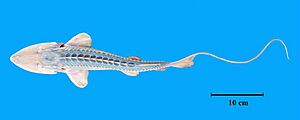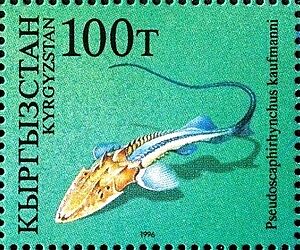Amu Darya sturgeon facts for kids
Quick facts for kids Amu Darya sturgeon |
|
|---|---|
 |
|
| Conservation status | |
| Scientific classification | |
| Synonyms | |
|
The Amu Darya sturgeon (Pseudoscaphirhynchus kaufmanni), also called the false shovelnose sturgeon, is a special type of fish. It belongs to the Acipenseridae family, which includes all sturgeons. This fish is very rare and is considered critically endangered.
You can find the Amu Darya sturgeon in parts of Turkmenistan, Uzbekistan, Tajikistan, and possibly Afghanistan. It likes to live in rivers where the water flows slowly and is a bit cloudy or muddy. It prefers shallow areas.
Contents
What Does the Amu Darya Sturgeon Look Like?

The Amu Darya sturgeon is a small sturgeon, but it's the biggest among its close relatives in the Pseudoscaphirhynchus group. It can grow up to 75 cm (30 in) (about 2.5 feet) long and weigh around 2 kg (4.4 lb) (about 4.4 pounds).
One of its cool features is a long, thin tail that looks like a filament. For example, some sturgeons that were about 55 cm (22 in) long without their tail could be 77 cm (30 in) or even 85.5 cm (33.7 in) long when you include the tail!
These sturgeons can also come in two different forms, or "morphs." One morph is usually larger and lighter in color. It also takes longer to become an adult. The other morph is smaller, darker, and becomes an adult more quickly.
How Does the Amu Darya Sturgeon Live?
The Amu Darya sturgeon mostly eats small fish and tiny insect larvae that live in the water. Bigger sturgeons prefer to eat other fish.
Scientists studied these sturgeons in the 1960s and 1970s. They found that Amu Darya sturgeons become adults when they are 5 to 8 years old. Females usually mature a little later than males. However, in the 1990s, some sturgeons were becoming adults as young as 4 years old. This might be because their environment changed.
They lay their eggs between March and May, when the water temperature is about 14 to 16 °C (57 to 61 °F). A large female can lay many eggs, from about 3,100 to 36,500 in one season! A small female lays fewer, around 1,000 to 2,000 eggs. It's thought that they might only lay eggs every 4 to 5 years. These fish can live for more than 14 years.
Why Is the Amu Darya Sturgeon Endangered?
The Amu Darya sturgeon used to live all over the Amu Darya river system, even reaching the Aral Sea. Today, you can only find them in certain parts of the Amu Darya River in Turkmenistan and Uzbekistan, and in the lower Vakhsh River in Tajikistan.
Their numbers have dropped a lot because of several reasons:
- Habitat Loss: Their homes in the rivers are being changed or destroyed.
- Pollution: Water pollution makes it hard for them to survive.
- Poaching: People illegally catch them, even though they are protected.
Because of these threats, the IUCN (International Union for Conservation of Nature) has listed the Amu Darya sturgeon as critically endangered. This means they are at a very high risk of disappearing forever.
Even though they are in danger, the Amu Darya sturgeon is actually the most common type of Pseudoscaphirhynchus sturgeon left. Other related species, like the Syr Darya sturgeon (P. fedtschenkoi), might already be gone, and P. hermanni only has a very small number of fish left.
Scientists still need to learn more about the Amu Darya sturgeon's exact numbers. Part of their home is protected in the Amudarya State Nature Reserve. Even though it's against the law to fish for them, illegal fishing is still a big problem. The species has been protected by CITES Appendix II since 1998, which helps control international trade.
People have tried to breed sturgeons in captivity to help their populations. In the 1980s, there were attempts to breed the Amu Darya sturgeon, but the baby fish didn't survive. Since 2010, groups have been trying again to start a breeding program, but it has been difficult to succeed so far.
Images for kids


